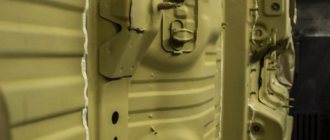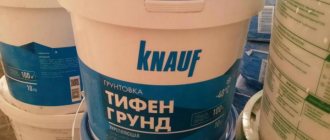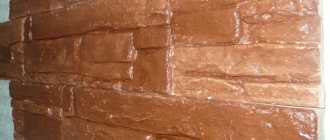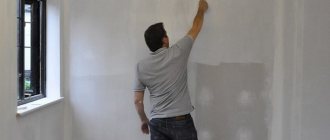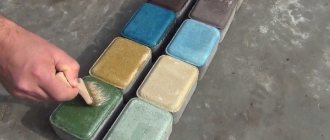Primer for concrete is a special composition designed for treating concrete surfaces. Additional finishing coatings are subsequently applied to it. After such treatment, the walls become more resistant to internal and external factors. Primer is an important component with deep-penetrating and strengthening properties. It prevents the negative influence of an aggressive environment, thereby increasing the service life of the walls. The primer also allows you to apply building mixtures as evenly as possible in the future.
Why is priming necessary?
When starting new construction, it is necessary to first resolve the issues of protecting concrete from the destructive effects of the external environment. Structures made on the basis of artificial stone are defenseless under the influence of precipitation and solar radiation . As a result, surfaces quickly lose their decorative properties, wear out, and peeling and cracks develop prematurely.
To prevent this, it is recommended to use primers for exterior use. Modern materials fully provide additional protection for facades and other concrete structures. The use of primers allows you to reduce the consumption of finishing paints and varnishes and make the coating more durable.
Each primer composition gives the base its own specific set of properties
The main ones include the following:
- increasing the level of adhesion between finishing layers and the base;
- increasing the resistance of the coating to external influences and operational loads. Such characteristics are achieved by filling the pores of concrete, which leads to its compaction and strengthening;
- protection from negative atmospheric factors . The material creates a film on the surface that provides hydrophobic properties.
The choice of material should be based on the type of base. They work on concrete with specialized or universal means.
Primer function
Figure 1. Applying a primer for concrete
Any concrete surface is prone to gradual destruction. They are influenced by many factors that negatively affect the condition of the building material. Thanks to the use of a primer, it is possible to significantly slow down any negative processes. Primers have the following abilities:
- Ensuring uniformity. Thanks to the use of soil, a uniform coating can be achieved. Such compositions penetrate even into small pores, thereby leveling the surface. Next, any building compounds can be applied to the treated wall.
- Ensuring the maximum level of adhesion between building materials.
- Creating a durable surface on concrete. A concrete primer helps minimize the risk of walls peeling off in chunks in the future.
- Protection from adverse environmental factors such as chemicals, bacteria, mold.
- Saving on construction material consumption. The primer penetrates and evens out all pores.
- Preventing excessive moisture in concrete, ensuring waterproofing.
How it works
When carrying out external work, primer compositions are applied before plastering, putty, painting and other layers. The need for impregnation is due to the fact that bases made on the basis of artificial stone actively absorb moisture from the mixtures. In the absence of primer preparation, absorption will be uneven, the finishing layer will not have time to adhere to the surface, which will cause peeling. The soil will prevent this process and increase adhesion.
Materials for external concrete work have additional functionality:
- strengthening the surface layer of structures . Particles of primer mixtures penetrate into the pores of concrete, forming strong bonds after complete hardening. No dust is formed on the surface, mineral materials do not crack or crumble;
- penetrating waterproofing . Deep penetration compositions help clog open pores. Moisture and water from precipitation stops seeping into the thickness of the concrete. Such protection significantly increases the frost resistance and, as a consequence, the durability of the foundations.
Additionally, primers are applied to the plaster layer .
As is known, this surface is heterogeneous and is characterized by different densities. This may cause uneven distribution of finishing compounds. The operation will reduce the consumption of materials used.
Properties of primers
Despite its strength, concrete has the following “weak” sides, which can be compensated for using a primer:
- Required level of adhesion (adhesion of concrete mortar to the surface). This is especially true for perfectly smooth substrates, on which it is most difficult to lay not only cement-sand mixtures, but also paint, wallpaper, linoleum and other coatings.
- Protection against excessive moisture of the base. The fact is that concrete is a porous material that very strongly absorbs moisture, which has a detrimental effect on the base, accumulating and expanding in its capillaries. If the surface is coated with primer, it will act as a sort of waterproof barrier to prevent clogging.
- Most mixtures contain antiseptic substances that prevent the formation of fungus and mold.
- Primers for concrete for painting or plastering allow finishing liquids to be absorbed evenly over the entire surface to be treated.
Of course, without a concrete primer, your house will not fall apart, but if you want the concrete coating to last longer, then primer compounds will be simply irreplaceable. To choose them correctly, you need to decide on the types of such mixtures.
Choosing the optimal solution
Various groups of primers are widely used. When choosing, you should take into account the compatibility of the materials that will be used in the construction of intermediate and finishing layers. If the surface is used under special conditions, a special primer should be used.
The functionality of the main ones is as follows:
- reinforcing – designed for work on plastered surfaces, which are characterized by an unstable, loose structure with a large number of micropores;
- deep penetration primers - this solution is relevant for weak bases;
- anti-corrosion - similar compounds work on reinforced concrete. Anti-corrosion properties will have a good effect on the protection of reinforcement;
- compositions with increased adhesion - soil is in demand on concrete with an increased amount of contaminants of inorganic and organic origin;
- universal - materials of this type work on concrete, reinforced concrete, and loose surfaces.
Primers for exterior use are divided according to the type of binder into alkyd , latex , acrylic , polystyrene , polyurethane , phenolic, etc.
Types of primer by composition
In any construction market you will be offered a lot of different primers. They all differ in purpose, and more precisely, in composition. You need to choose from your preferences and the tasks that you put forward for the composition.
- Polyurethane or polystyrene primers. Very toxic, intended for outdoor use. Typically used to treat building facades. Such primers fill small cracks in concrete surfaces, thereby increasing their service life.
- Acrylic primers. They are practically odorless, quickly absorbed and compatible with any building materials. Due to rapid drying, work can continue 3-4 hours after applying the primer. Acrylic can be used for interior work.
- Water based. Absolutely safe, used for interior work.
- Organic primers. They penetrate deep into concrete, making them necessary for processing low-grade mixtures. Can be used at sub-zero temperatures. Such primers evaporate quickly, which is why they have a short service life.
- PVA and epoxy primers. They have a maximum hardening time. Designed to improve the adhesion of walls to other materials. The compositions are suitable for use indoors and on facades.
Acrylic
The cost of such materials is 150-900 rubles. For exterior concrete work, it is recommended to choose deep-penetrating acrylic primers with an antiseptic effect.
Main technical characteristics:
- type of work – external, internal, universal;
- colorless;
- tinting - no;
- surface – concrete, plastered concrete, painted concrete;
- gloss level – matte;
- properties – quick-drying;
- thinner – water;
- dry residue – 10%;
- density – 1 kg/l;
- drying time – 30 minutes;
- layer-by-layer drying – 1-2 hours.
Scope of application
The primer reduces and evens out the absorbency of the substrates. Strengthening the surface layer of concrete, including those that highly absorb moisture, is achieved.
The material improves adhesion, reduces the need for finishing coatings, and ensures the most uniform application of subsequent layers.
Antiseptic additives protect concrete from mold and mildew. The covered structure becomes weather- and moisture-resistant.
Consumption of deep penetration acrylic primer: 5-14 sq.m/l – per layer. The actual requirement depends on the method of application and the porosity of the concrete.
Application method
The concrete base must be strong, dry, cleaned and hard. The surface is freed from contaminants such as lime, chalk, weak, flaking layers. Mechanical cleaning and subsequent drying of compressors with compressed air are used.
The temperature of concrete, air, primer should be above +5 degrees, relative air humidity - below 80%. Before use, the composition is mixed, if necessary, diluted with water by 30% of the volume. Acrylic primer is applied with a brush, roller or spray in 1-2 approaches, observing layer-by-layer drying for 1-2 hours. After this, the instrument is washed with water.
Review of popular manufacturers
Let's consider the most popular brands of primer for concrete that meet the requirements of GOST 31384-2008 for the protection of concrete bases:
- Ceresite – increases adhesion, penetrates deeply into the base, and provides surface protection from aggressive environments. This solution can be used before any type of finishing, including under tiles, since it creates a protective film for better adhesion.
- Lakra is an impregnation made on the basis of polyurethane. It has an antibacterial effect, so it perfectly protects the base from fungi and mold. Impregnation is intended for use in rooms with high humidity.
- Optimist – suitable for both interior and exterior work. The products of this brand contain latex and modifying additives, which ensures high adhesion and allows you to create a perfectly flat surface.
- Prospectors - perfectly fills pores and microcracks, contains quartz sand, which increases adhesion. This solution is recommended for use in rooms with high humidity.
Using a primer allows for a better finish that will last longer. The main rule in such work is the correctly selected solution and compliance with the operating instructions.
Structural acrylic primers
The cost of structural external primers is 920-1700 rubles. Such materials contain quartz particles and are actively used for decorative plasters.
Main technical characteristics:
- type of work: universal, external, internal;
- White color;
- tinting: possible;
- application surface: concrete, plastered concrete;
- gloss level: matte;
- properties: quick-drying primer.
Acrylic primers are diluted with ordinary clean water
Scope of application
Structural primer is used for pre-treatment of concrete, foam concrete, plastered, putty, and water-dispersed concrete before applying decorative plasters.
Peculiarities
Forms a rough structure on smooth concrete, improves adhesion. Materials of this type are presented in white, which evens out the color of the surface and compensates for contrasting color differences in the bases. Structural soil is characterized by high vapor permeability.
Application method
The composition is applied to concrete, cleaned of grease stains, dirt and dust. The base must be dry and durable. If working on previously painted surfaces, peeling layers should be removed. Next, the surface is sanded and freed from abrasive residues.
The soil itself is ready for use, but requires preliminary mixing with a construction mixer. Application is carried out with a brush or roller with short pile. When working outdoors, primer should not be applied during rain, at temperatures below +5 degrees.
Under favorable conditions (air humidity no more than 65%, temperature +20 degrees), the primer dries in 120 minutes. Finishing layers are applied no earlier than after 12 hours. Average consumption is 5 sq.m/l.
Acrylate primers for concrete
The cost of the material varies from 500 to 880 rubles. Penetrating acrylate primer is designed to work on highly absorbent substrates, strengthening and normalizing concrete. Additionally, dustlessness and increased adhesion of all layers are ensured. The primer is vapor-permeable and effective for preparing for painting, plastering, and puttying.
Main technical characteristics:
- type of work: external, internal, universal;
- color: colorless;
- application surface: concrete, plastered concrete;
- gloss level: matte;
- properties: quick-drying;
- thinner: water;
- density 1 g/cc.
Application method
The material is applied at positive temperatures with rollers, brushes or spray. 1-2 technological approaches are carried out. Under favorable conditions, the soil takes 2 hours to dry until it is tack-free. Drying time between layers is 4 hours; complete drying requires 6 hours.
Specifications table
| Characteristics | Unit measurements | Meaning |
| Soil consumption | g/m2 | 50-300 |
| pH | 7,0-8,5 | |
| Penetration depth | mm | 5-10 |
| Drying time | h | 2-6 |
| Application temperature | °C | +5/+35 |
| Operating temperature | °C | -40/+60 |
| Maximum particle size | µm | 0,05 |
Alkyd
The cost of alkyd primers is 790-5600 rubles.
Main technical characteristics:
- type of work: external, internal, universal;
- tinting: possible;
- gloss level: matte;
- thinner: solvent.
Alkyd primers work not only on concrete, but also on natural stone
Peculiarities
The material is intended for external and internal work. The primer creates an adhesive bridge between the base and the finishing coating. This is the optimal solution for painting.
Method of application
Like all other primers, the composition is applied with brushes, sprayers, and rollers.
Penetrating primer for concrete latex
The cost of primers varies between 290-540 rubles per 5 liters. Latex compounds effectively strengthen the base, isolate the growth of mold, bacteria, fungi, and reduce the consumption of subsequent layers.
Main technical characteristics:
- type of work: external, internal, universal;
- color – no color;
- tinting is impossible;
- application surface: concrete, plastered concrete;
- gloss level: matte;
- properties: quick-drying soil;
- thinner: water;
- penetration depth into concrete – up to 7 mm.
Scope of application
The material is in demand when preparing concrete for subsequent finishing (painting, puttying, laying tile materials). Latex primer works when installing floor coverings and self-leveling mixtures. After polymerization, a transparent film is formed on the concrete, optimizing its absorbency.
The soil is used to prevent the possibility of mold and fungi. Elimination of dusting, chalking, strengthening, and durable protection of concrete are achieved . The formation of microcracks is blocked. Latex primer protects the base from getting wet, penetration of inorganic salts, and water into the paint layer. The finished layer can withstand high temperatures.
Peculiarities
Latex primers are non-toxic, explosion- and fire-proof, environmentally friendly, and practically odorless.
Application method
The temperature of concrete and air should be within +5+35 degrees. The well-mixed composition is typically applied with rollers, brushes or sprayers. Average consumption – 100-250 ml/sq.m. Applying 1-2 layers is enough. Drying time for each layer is 30 minutes. Complete drying is achieved after 2 hours.
Description and characteristics
Primer for concrete is almost always liquid. This is what determines the method of its application. For example, it can be applied by spray, brush or roller, which directly depends on the volume of work, density and other factors. Otherwise, the characteristics are determined by the specific type of product, where the following areas are distinguished:
- Polishes the surface. The surface of the concrete itself is only externally smooth. In fact, it consists of many small cells, which are then visible after painting. By using the right primer, we can polish out these pores or fill them, which improves the aesthetic properties after painting. This is convenient when painting a ceiling surface made of floor slabs.
- Protects against mold. This is relevant if the room is for utility purposes, which may not be heated at all or partially. The external aesthetics of the walls will improve as there will be no dark spots or fungal growths.
- Increases the adhesive ability of walls. This is relevant when tiles are glued to the walls. For example, here we use a concrete contact primer , which has a red or pink tint. Unlike the first characteristic, concrete contact coats the wall with an abrasive, rough compound, which increases adhesion.
- Increases the strength of concrete. This is especially true for concrete outside, as this is where it is exposed to moisture. By impregnating the surface with a primer, we close pores and microcracks. Therefore, water will not get here, which means that in winter, when freezing, there will be no destruction.
- We reduce the consumption of finishing materials. By using a primer, the consumption of paint, wallpaper and tile adhesive is reduced by approximately 25 percent. The primer itself is inexpensive, so its use allows you to reduce budget costs.
The main characteristic of the primer is the protection of the concrete itself. It envelops the surface with a protective layer, after which the natural moisture of the product is preserved, which ensures normal humidity of the walls.
Hydrostop concentrate primers
The cost of the compositions rarely exceeds 270 rubles.
Main technical characteristics:
- type of work: internal, external, universal;
- color: blue, white;
- application surface: concrete, plastered concrete;
- gloss level: matte;
- thinner: water.
Hydrostop concentrate primers are not tinted and are available only in white or blue colors
Peculiarities
Concentrated primers for exterior use protect concrete foundations from moisture. Biocidal additives prevent the appearance of mold and mildew. A reduction in the consumption of finishing materials and improved adhesion are achieved.
Application method
Concentrated soil requires dilution with water in a ratio of 1:2 or 1:5. Work is carried out at positive temperatures using sprayers, brushes, and rollers.
Polystyrene, polyvinyl acetate primers
Polystyrene primers contain solvents, so they are most often in demand for finishing facades and in industrial premises. The material creates a durable adhesive film with concrete and some specific types of paints. In addition, polystyrene primer does an excellent job of protecting the surface.
Polyvinyl acetate primers are also worthy of choice. This solution is perfect for subsequent concrete painting. Compositions of this type dry quickly and can be used for short work periods. Drying time is 30-40 minutes. The material provides a high degree of adhesion no worse than others.
Conclusion
It should also be noted that there is a common misconception that strengthening soil, when added to a concrete solution, makes it stronger. Professionals say that this technique can be used to make some types of plaster. When added to a concrete solution, it will be wasted money. (See also the article Impregnation for concrete floors: features.)
Epoxy primer for industrial premises.
Universal penetrating primer for concrete
Compositions of this type are used for any density and grade of concrete. However, maximum performance is achieved on surfaces with increased porosity. The depth of soil penetration is 5-9 mm . In addition, the base immediately gains increased adhesive capabilities. The material is indispensable for protecting and strengthening loose, old concrete walls. Average consumption – 300 g/sq.m.
Advantages and disadvantages
Let's consider the main advantages of this kind of mixtures:
- the primer allows the finish to adhere more tightly to the base;
- solutions prevent the appearance of various types of defects on the surface in rooms with high humidity;
- the material provides the base with protection from damage;
- there is a wide range of products on the construction market that allows you to choose the optimal composition for any type of base;
- primers also come in different colors, which frees the owner from further painting;
- surface priming provides protection against corrosion, mildew and mold;
- such compositions make it possible to create a surface that is as smooth and uniform in structure as possible;
- primers do not contain toxic substances;
- they are resistant to moisture and temperature changes;
- the price of such mixtures is affordable, so any consumer can afford it;
- Primers are easy to install.
Flaws:
- high probability of stains penetrating from the surface onto the material;
- the possibility of forming a non-uniform glossy base.
How to prepare concrete for priming
Before you start priming, you need to prepare the concrete. The type of work depends on the actual condition of the surface. Most often, it is enough to use mechanical processing (using grinding machines, milling cutters, high-pressure apparatus, shot blasting, sandblasting machines).
The base must be well dried , for which compressed air or heat guns are used. The remains of old finishing layers are carefully cleaned off. Paint and varnish materials can be easily removed with a spatula and using chemical treatment.
If greasy or oil stains are found on concrete, a 5% solution of soda ash should be used. Dilution proportions: 400 gr. soda: 10 liters of water. Traces of corrosion are treated with a 15% solution of copper sulfate. You can use ready-made compounds for anti-corrosion treatment of concrete.
The surface is always checked for defects . If they are found, jointing is carried out. Next, apply a primer and putty. Only those materials that are intended for repairing concrete foundations are used.
For deep defects, it is recommended to apply the finished compounds in two layers. Each layer requires careful drying
After puttying, the surface is once again processed with floats or sanded with concrete finishing machines , dust-free and primed in accordance with the manufacturer's recommendations.
Features of priming before plastering
The base for plaster must be level. Irregularities are identified using a laser level and eliminated. Further preparation follows general principles: the concrete is inspected for cracks. If a defect is found, the crumbling areas are chipped off and repairs are carried out . Next, the base is cleaned of dirt and dust. Grease stains must be removed. It is recommended to apply two layers of primer under the plaster.
Sequence of work:
- prepare the primer composition in accordance with the manufacturer's recommendations. Mixing is carried out using a construction drill with a mixing attachment;
- the soil is poured into the tray;
- dip a roller into the composition and remove excess;
- Using a roller, apply the primer evenly over the surface (walls, floor, etc.). The solution should lie as evenly as possible without smudges;
- hard-to-reach areas are covered with a brush;
- After the first treatment, the layer is allowed to dry, after which the second layer is applied.
Features of priming concrete before puttying
This technological operation is most often preceded by the application of acrylic compounds. They are universal and designed for processing any concrete. It is important to apply the primer as evenly as possible, since putty involves the use of thin layers. The treatment is repeated until the concrete stops absorbing the material.
How to Prime Previously Plastered Concrete
They use reinforcing and adhesive compounds on plastered concrete. Both varieties are supplied ready-made or as dry mixtures. For mixing, organic solvents or water are used . Strengthening primers are used for the initial treatment of concrete bases. The function of primers is to create a uniform layer with a penetration depth of 3 to 10 cm. Adhesive - provide better adhesion between layers.
Application instructions
In the instructions for using primers, manufacturers indicate the requirements for the surface to be treated and describe the application technology.
Surface preparation
Considering that the walls inside and outside the building, the ceiling and floor are primed for a specific type of finish, intermediate or final, it makes no sense to consider in detail the technology for preparing the surface for plaster, paint or wallpaper: each type of finish has its own requirements.
Detailed instructions can be found in the works:
- “How to prepare walls for plaster?”;
- “How to prepare walls for wallpapering?”;
- “Leveling walls for painting”;
- “How to prepare a ceiling for painting with water-based paint?”;
- “How to put wallpaper on the ceiling?”;
- “How to fill a self-leveling floor on a balcony?”
Let us briefly recall some points:
- there should be no oil stains on the treated surface - latex does not penetrate through them through capillaries into the materials;
- existing metal parts are either removed or treated with anti-rust;
- highly porous materials and cracks are sealed with special solutions or cement laitance;
- dust and debris are removed.
Manufacturers of primers for exterior use
The high quality of processing and operation is demonstrated by materials from domestic and foreign manufacturers.
Volma
The company produces several types of primers, among which the Volma-Plast composition deserves special attention. This is a deep penetration primer. A durable waterproof film with antiseptic characteristics and good vapor permeability is formed on the surface of the concrete.
Volma-Plast is supplied in containers with a volume of 10 liters. The material is ready for use and does not require dilution .
Before application it is a milky color, after drying it becomes transparent. Consumption – 50-100 ml/sq.m.
Another product from this manufacturer, Volma-universal, works well on facades. It helps reduce moisture absorption, compacts the surface, and significantly increases adhesion. The soil layer is vapor permeable and characterized by antiseptic properties. Application can be done manually or using sprayers. Consumption – 150 ml/sq.m. Used in original concentration, no dilution required.
Knauf
The brand offers a product such as Knauf Grundiemittel. It is better to work with this soil if the base is made of foam or gas blocks. The material is used in its original consistency or diluted (1:3). The manufacturer produces the primer in a container of 15 kg . This is a very economical option - consumption does not exceed 100 g/sq.m. But the cost of the primer cannot be called low.
Ivsil
Primers from this manufacturer work well on highly absorbent substrates. It is recommended to pay attention to deep penetration soils from Ivsil. Such compositions are characterized by additional antiseptic properties, which is due to the presence of fungicides. Typical primer volume is 10 liters. However, you should count on increased consumption - 180-250 ml/sq.m.
Siltek
The brand has developed the composition Siltek E-110. This is a strengthening primer for treating porous walls both outside and inside buildings. The basis is a polymer dispersion and modifying additives. The material is in demand when processing degrading, weak concrete .
A water-repellent layer with good vapor barrier properties is formed on the surface. The primer is applied manually, in 2-3 technological approaches. Consumption – 200 ml/sq.m. Complete drying occurs quite quickly - after 4-6 hours.
Types of primers and their purpose
In the description of many types of work it is written: priming of the base is required. For this stage, special compounds are used, which are called primer or primer.
Applying primer is one of the stages of finishing work
What is primer (primer) or priming compound? This is a liquid construction mixture that prepares the surface for applying the next layer of finishing. Moreover, the “next” can be anything, either intermediate or final. Let's take wall finishing as an example - from bare masonry to painting or wallpaper. First, the wall itself is primed from the building material. After the soil has dried, plaster is applied. When the plaster has dried sufficiently, apply primer to it, then putty. The puttied surface is also primed, and then after the primer layer has dried, painted or wallpapered. This number of coats of primer is not necessary, but is an option.
A primer is a liquid composition that ensures good adhesion of the finishing layers to each other.
The primer is used when finishing walls, floors, ceilings, and facades. In general, everywhere. There are subspecies for external and internal work, some that are used in both.
Types of primers
As we saw from the example, the base on which the primer is applied varies. For example, a concrete and foam block wall, a concrete floor, a plasterboard or putty ceiling. They are completely different in characteristics. This means that different preparation is required, covering the problems of a specific material. There are different primer compositions for solving each problem. In general, based on the results of the action, four groups are distinguished:
- Filling. These are compounds that reduce the hygroscopicity of the base and its absorbency. Apply to highly absorbent surfaces. Designed for leveling small unevenness and filling joints in ceramic tiles, plank floors and parquet before filling. They are applied: under the paint to reduce its consumption and so that it goes on smoother,
- under the plaster so that the wall does not draw moisture from the plaster composition and it has enough moisture to gain the required strength,
- on a plastered wall under tile adhesive to slightly extend the “lifetime” of the adhesive due to the fact that the liquid will be absorbed more slowly,
- on plaster or putty before gluing wallpaper, so that the surface absorbs glue more slowly, etc.
Division according to different criteria. May be useful
Of all the variety of bases, the most common are acrylic primers. They fill approximately 80% of the market
There are also universal primers. They are the cheapest. The description usually contains a fairly solid list of properties. In fact, all-purpose primers contain the least amount of active ingredients. This is also soil, but weaker. This type should only be used if there is no urgent need for a primer. For example, under wallpaper or paint.
Problems solved by primers
Primers should ensure good adhesion of the two layers. This is their main purpose. Most often, this requires adjusting the absorbency of the base. The fact is that all finishing materials - plasters, putties, paints, glue - are developed for medium-absorbent substrates. And there are not many of them. More often you have to adjust the absorbency. Sometimes you need to reduce absorbency, sometimes you need to create a sticky film on a surface that is too smooth and/or poorly absorbent. Primers solve this problem.
And compositions that reduce absorbency simultaneously improve waterproofing and combat high humidity. So this is also part of their tasks. And for this they are also used.
Primer is needed to improve adhesion
Deep penetration primers bind particles on the surface. The compositions penetrate deep into loose materials to a sufficient depth - 5-7 mm and bind the particles together. Often a “side” effect is a decrease in hygroscopicity and absorbency. Often does not mean always, so look at the properties in the description of each composition.
Even after the primer has dried, an adhesive film may form on the surface, since the unabsorbed composition dries and leaves a sticky mark. This improves the conditions for applying the next material. That is, some types of primer increase surface strength and adhesion. Some other formulations have antibacterial properties, while others simply contain special anti-mold or antifungal additives.
Sometimes a primer is used to “make friends” with cement and gypsum-based materials. Without this, there will be no normal adhesion. For example, when a concrete wall or a wall made of cement-based blocks is going to be covered with gypsum plaster, the classic and proven solution is Concrete Contact from Knauf. It is applied to almost any mineral base under gypsum materials and ensures their high-quality bond.
Types of bases for priming
So, we came to the conclusion that when selecting a primer, you need to focus on the properties of the base. Based on their absorbency, they are divided into three groups:
- Low absorbency and non-absorbent. This group includes concrete surfaces, cement plasters, refractory bricks, sand concrete, expanded polystyrene, gypsum tongue-and-groove slabs.
- With medium absorbency. Ordinary brick. An ideal base that does not require primer. But only if the brick has not yet begun to crumble.
Wood is a complex substrate that requires application of primer - With high absorbency. Gas silicate, foam concrete blocks and any cellular concrete, white sand-lime brick, gypsum and lime, cement plasters and mixed plaster mixtures.
How to determine the absorbency of a surface? Apply drops of water to the surface and track the time it takes for them to absorb. If it took more than 20 minutes, the surface is non-absorbent; if less than 3 minutes have passed, it is highly absorbent. Everything in between is medium absorbent. In this case, you are lucky and you can do without compounds that regulate water absorption.
Now it’s clear how to select a primer. For surfaces with low absorbency, film-forming primers are suitable, and for those with high absorbency, deep penetration primers or fillers are used. Deep penetrations are only needed if the surface is dusty, but not loose or crumbling.
Tools and equipment
Preliminary surface preparation is carried out using professional equipment. These can be high-pressure apparatuses, concrete finishing machines, milling cutters, shot blasting, sandblasting machines. Additionally, industrial vacuum cleaners and hard metal brushes are used.
To work with primer compositions you will need:
- rollers, brushes . At the priming stage, this tool is the main one. Paint brushes help to better fill in uneven surfaces, but rollers make the job much easier. The optimal width of brushes is from 10 cm, of rollers – 18-20 cm. The fur coat should be made of artificial material;
- air and airless spray guns . Equipment of this type is in demand for large volumes of work. Ensures fast and uniform application of primer mixtures;
- narrow paint brushes – used for processing concrete with complex configurations, corners and other hard-to-reach areas;
- painting trays – the equipment allows you to conveniently collect soil, without excess.
Safety precautions
Processing of external concrete structures is always carried out in compliance with safety standards. Primers are applied under favorable weather conditions, in dry weather, in the absence of strong wind . If required, special means of scaffolding are used: platforms, scaffolding, etc. The work area must be fenced.
Only adult workers who have received preliminary instructions and medical clearance are allowed to prime and prepare concrete foundations
Personal protective equipment is required: overalls, gloves, goggles, and, if necessary, respirators.
Tips for buying a primer
Below are some tips when purchasing a primer:
- Regardless of the type of soil, it is better to buy a mixture that has antiseptic protection. This will prevent mold from forming. If the surface is exposed to high humidity, then the mixture must be purchased with a large amount of antiseptic.
- When purchasing a primer, you need to consider the conditions in which it will be used - for external or internal work. For facade finishing it is better to buy facade primer. Its plus is that it does not dry out very quickly, and this is important. For interior finishing, any primer can be used.
- It is important to take into account the parameters of the material. Manufacturers sell a large number of types of soil that are designed for specific substrates. The products differ in viscosity and in the components that are included in the composition.
- It is better to purchase soil from a well-known company rather than give preference to cheap, incomprehensible options.
- Primer for concrete can be counterfeit. It is important to study the date of manufacture and security marks. Such means will not give a good result in the end.
This article contains the necessary information that will enable you to choose the right type of product for working with a concrete base.
A correctly selected primer composition will qualitatively protect concrete from various external influences, and this will make it possible to carry out repairs well.


